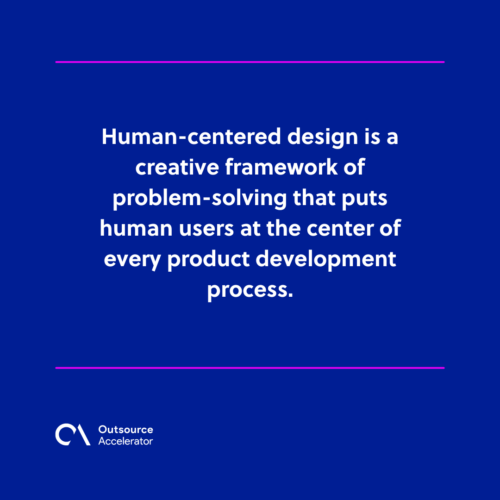Human-centered design
Definition
What is human-centered design?
Human-centered design is a creative framework of problem-solving that puts human users at the center of every product development process. With this approach, the business aims to develop innovative solutions that will specifically address customers’ needs.
Human-centered design is about having a strong empathy for the people you’re designing for. It includes coming up with various ideas, making several prototypes, undergoing user-testing, and eventually releasing solutions that can revolutionize the market.
Why is human-centered design important?
Following a human-centered design allows a company to diversify opportunities for product development. When the user is at the center of everything, you can better understand and adapt to the changing demands of the market.
Further, a human-centered approach provides businesses with an understanding of the opportunities, which can improve customer satisfaction. When customers feel like they’re a part of the process, the product takes on new significance for them, and they’re more likely to use it.
4 phases of human-centered design
To fully develop an innovative solution for the consumers’ demand, here are the four phases of human-centered design:
Define the problem
Ask questions to get a better understanding of the situation from the user’s perspective. Identify your assumptions so you may change them if they don’t match the reality of your users.
First, you must identify the appropriate individuals. Consider various characteristics such as age, ethnicity, and technological skills. Consider this to be fundamental research, which might involve interviews if necessary.
All of this contributes to the development of empathy for your users. As a provider, put yourself in their shoes, understand their experiences, and open yourself up to new creative possibilities for your business.
Visualize the solution
After you’ve identified your users and conducted your research, summarize the data and interpret what you discovered during the definition phase.
Affinity mapping is a common approach for summarizing results. Everyone puts their observations on individual notepads, which are then grouped together to discover patterns.
Summarizing the data, you take your ideas and insights and turn them into design possibilities, brainstorming as many concepts as you can.
Prototype and test
After brainstorming, it’s time to choose the best ideas and construct prototypes. Prototypes are low-cost projections of how your solution will appear, and they may take many forms, including paper sketches, role-playing, actual items, and digital prototypes.
You can directly and immediately build digital wireframes and prototypes using various tools. It is crucial to test various prototypes and share them with your target audience to get feedback and choose the best course of action.
Implement
This is the stage when you have to take your product to market and make adjustments to your business plan. It is critical to understand that your product is not essentially done. You should always improve, test, and gather feedback from users to ensure that your product is meeting their changing demands.
Monitor your pre-defined success measures to see whether your product is meeting expectations. Human-centered design is relevant not just to the product but also to its presentation and promotion.








 Independent
Independent




